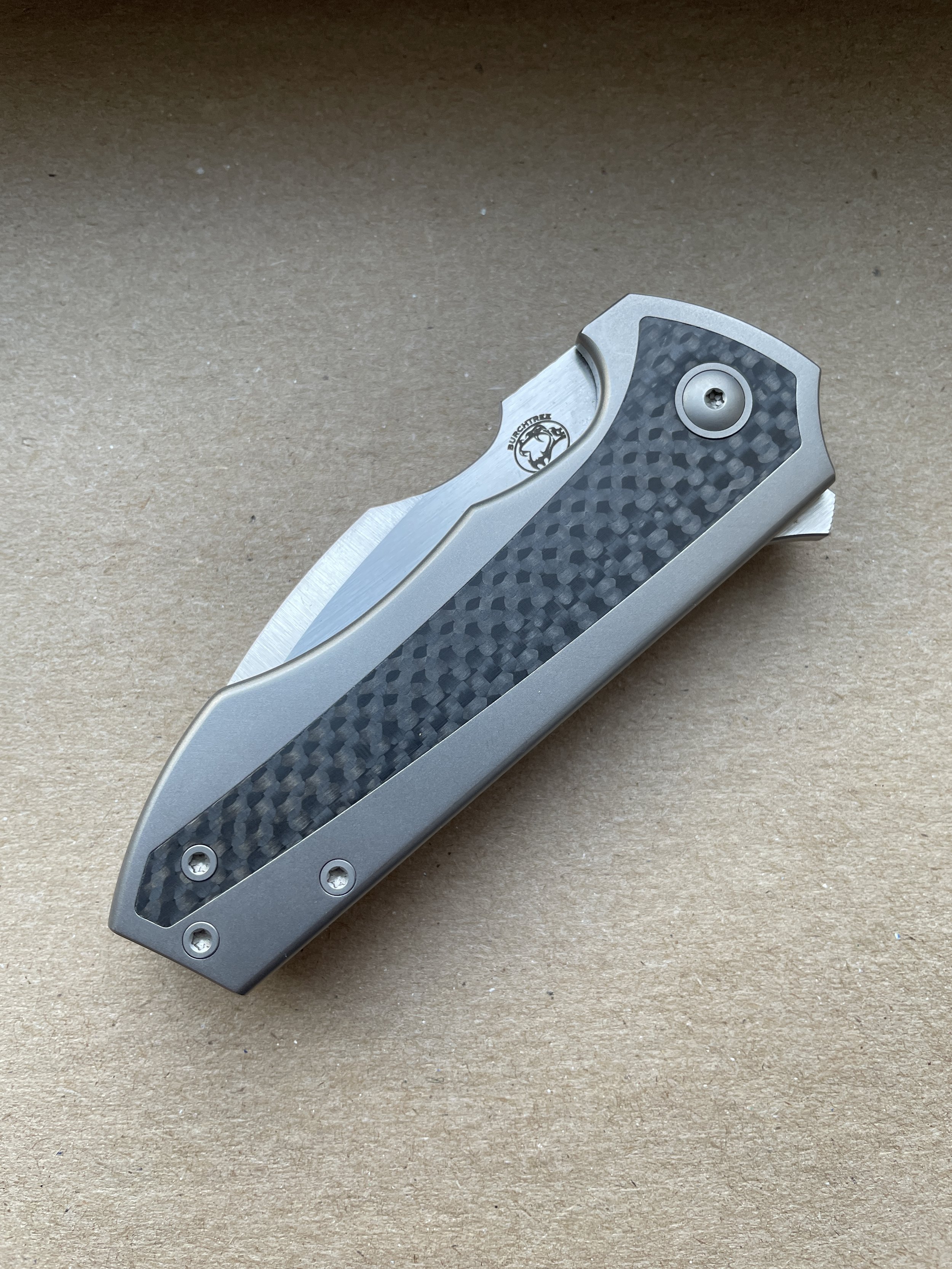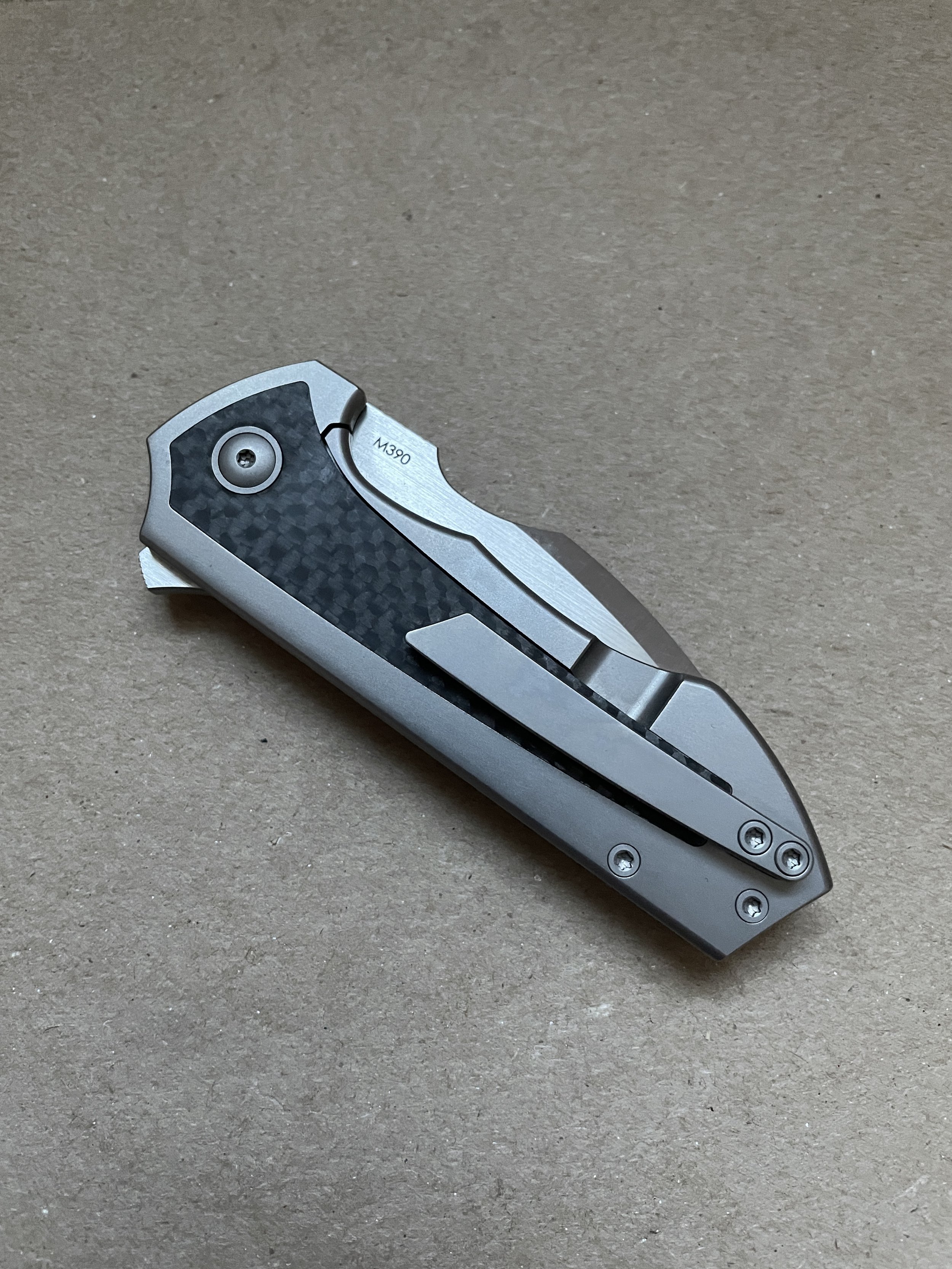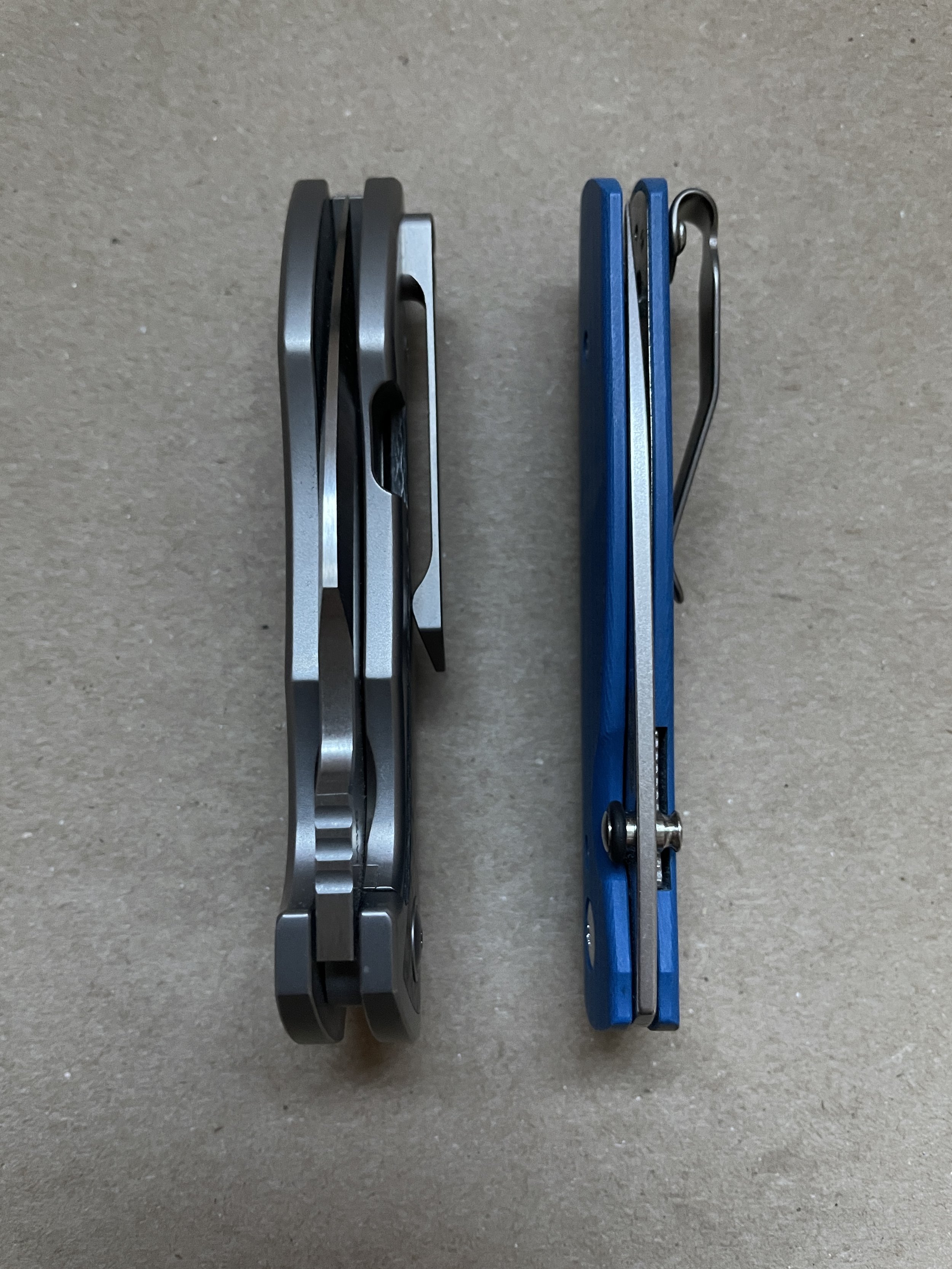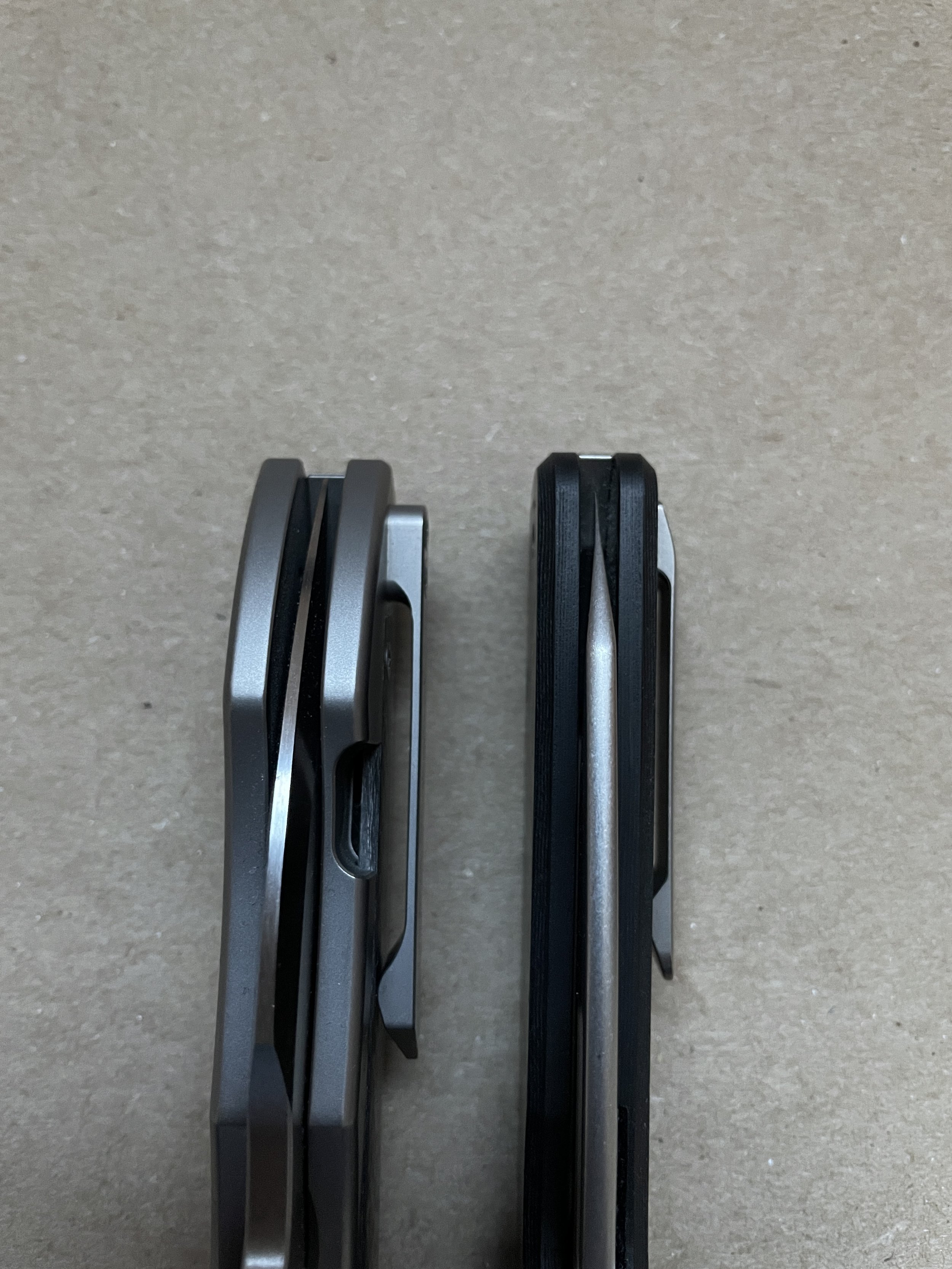Burchtree Bladeworks Euclid Review
Michael Burch is unquestionably one of the best custom knifemakers working today. His designs are distinctive and interesting and his knives are highly sought after. Like a lot of custom makers, he offers production versions of his knives so that more people can get his knives in their pockets. Some are collaborations with production companies, but many of his more recent offerings are self-published blades made by Reate. His most recent self-published blade is the Euclid. It is a very interesting knife and it serves as a milestone of sorts for where the knife business was and is headed. The name is fitting because this is a knife made interesting by its curves and angles. But some of them are good and some are not my favorite design choice. Let’s dig into this really engaging but flawed knife.
Here is a link to the product page. There are a slew of different Euclids. The variations come in two forms—different inserts and different anodizing on the handle. The micarta and weave CF inserts cost $350 while the marbled CF costs $380. Here is a video review. Here is the review sample (purchased with my own money):
Quick Review Summary: Engaging but dated.
Design: 1
The Euclid is a beautiful blade in silhouette. But when you make it into a 3D object, it seems, well, a bit out of step with the modern market. While production designs are pushing the materials envelope with light, stiff handles and superior steel, cranking out 2 ounce knives with Magnacut steel (see: Hogue Deka), the Euclid is dealing in slabby titanium and bulky blade stock. It is thick, heavy, and blocky. The materials, at this point, aren’t outstanding or unusual, either.
There are a few things that shine through the by-the-numbers knife design that save it from being a 0. The flipper tab’s geometry is the very best in the world. It feels so natural and easy that it just works every time. The curves and cuts on the handle and the spine are superb as well, offering safe places for your fingers. But those details stand out next to the dated and somewhat by-the-number TFF design.
Over and over during the review period, I couldn’t shake the sensation that the Euclid just feels old, like a knife from 2007. Putting it up against something modern like the aforementioned Deka or TRM Neutron 2 puts it dated design in stark relief. Here is the Euclid up against the Neutron 2:
If the handles were pocketed and slimmed down and the blade stock was 1/8th of an inch thinner, the Burch details would carry the day over the chubby design and the average materials (and no, a Mokuti insert isn’t the materials upgrade I am pining for).
As it is, its hard to shake the feeling that this knife comes from a different era, when everyone and their mother was releasing a titanium flipper midtech that was a paint-by-numbers version of their custom.
Fit and Finish: 2
Reate made the Euclid and so the fit and finish is glorious. The inlay is almost fingernail flush and the blade’s satin finish is quite nice and very consistent. Of course centering, detent, and lock up are perfect. But as Nick recently noted—excellence is the bear minimum in the knife world these days.
Grip: 2
Thanks to a few ingenious touches, the Euclid locks into the hand like few other knives do. There is a hidden forward choil (its a naked choil, so be careful) and a dip in the spine for a thumb to go into. The result in a knife that is amazing in multiple positions without forcing you into any one position. Overall, I think it is one of the better knives in hand on the market. Only one thing blemishes it—the squared off end to the pocket clip. Without a ramp, it seems like the clip is always poking you. Compared to clips on other more modern designs, the Euclid feels primitive. With this one change the knife might be the best in-hand folder on the market.
Carry: 0
How fat is the Euclid? It is a 3 inch bladed knife that weighs almost as much as a notoriously fat knife plus a Benchmade Bugout. That’s right, the Euclid (5.08 ounces) weighs almost as much as a Tencho 2 (3.40 ounces) and a Benchmade Bugot (1.85 ounces). When the Tencho 2 looks slim version of your knife, there is a problem. As one would expect, the Euclid carries like a boat anchor, being almost uncarry-able in shorts and doing a good job testing your belt in jeans.
Steel: 2
M390 is a good all around steel that is so overused I am beyond bored writing about it. The problem for the Euclid is that quite a few knives that are significantly cheaper, like the Hogue Deka and the Lionsteel Nano, run Magnacut and are at least $130 cheaper. M390 is a good steel, but its not even close to being a good value at this price. I won’t take points off for that (yet), but I will note it below in the value section.
Blade Shape: 2
Blade shape taxonomists, give up for yours is a pointless quest. If we had to get really precise, I would say this is a modified wharncliffe with a harpoon tip. The reality is, its a blade shape without a ton of belly that is pretty effective.
Grind: 1
When I write “pretty effective” I mean—it would perform better with a thinner grind or more to the point, thinner blade stock. The entire knife could be 25% thinner and that would make it 75% better. Here more than anywhere else, I wish the Euclid was following the evolution of folders and getting thinner. What’s the point of these ultra-hard and ultra-tough PM steels if you don’t make the stock thinner to really take advantage of the steel’s properties? The Euclid is not the only knife that does this, of course, but for this price and from this maker (who is on a podcast with the King of Thin Blades himself, Tom Krein), the Euclid should have been thinner. As it is, the grind is a flat grind on a taller than average blade, making the knife, again, pretty effective, despite its limitations.
Deployment Method: 2
I think Michael Burch is one of the best knife makers out there right now. The Euclid’s flipper tab and action are proof of that. No flipper tab anywhere in the knife world is even close. The angle on the tip of the tab (say that five times fast) and the fine jimping, coupled with a nicely tuned detent make the Euclid one of the best flippers out there, in the same range as something like the beloved Sharp by Design Micro Evo, which, I think, is the best flipper available. But the tab here is even better than the Micro Evos. So the question becomes one of preference—do you want the better tab or the better detent design? Either produce truly superior action.
Retention Method: 1
Agh! The clip. Its like it was imported directed from 2007, when folks hadn’t figured out how to make good sculpted clips yet. But with the excellent clip from Pena’s X-series and the superb clip seen on the Bridgeport Knife Co 395, this thing seems like an anachronism. Here is a side by side with the 395:
The clip will hold the knife on the pocket decently well, I wouldn’t say it is great at it. Its just meh in that regard, keeping a lot of the handle above the edge of your pocket. Of course it also screws up your grip, and I feel like this is the appropriate category to take points off, as the knife itself is pretty amazing in terms of grip, but for this clip.
For the record, the number of good designs made worse my a pocket clip is really high in the knife industry. How is that still happening? It would be like if the automotive industry saw the Corvair blow up and split in half during testing and still made cars like it.
Lock/Blade Safety: 1
As a related category to fit and finish, the lock up is great because the fit and finish is great. The big concern here, however, is access to the lock bar. Its not enough to take off a full point, but it is surprise that there is so little accommodation made for such a critical feature. Again, this seems like something from a bygone era of knife design.
Other Considerations
Fidget Factor: Very High
This is peak fidget factor, the knife is just amazing at flipping open.
Fett Effect: High
With a satin finish and a blasted handle this knife will mark up nicely over time.
Value: Very Low
Titanium framelocks are dime a dozen nowadays. If they have inlays, about 95% of them offer carbon fiber and/or micarta. M390 doesn’t really count as an exotic steel anymore. So what are you paying for here? The Burch design? But that design is blocky and overly heavy. And the blade, while nicely finished isn’t what I would think of as a slicey grind. In the end, the Euclid is basically par for the course in about a half dozen ways. Its price, however, is well above par. Hence the very low value determination.
Overall Score: 14 out of 20
You can catch glimpses of Burch’s greatness in this blade—the curve along the spine, the pleasing handle shape, the hidden choil are all nice. The flipper tab is world class. But so much of the rest of the knife strikes me a pretty generic, bulky, or outdated. The knife could have weighed half what it does and been a challenger for best in class. As it is, it is like the overweight ex-high school football player trying to relive his glory days—way too chubby and a bit out of touch.
If you prefer heavy knives then not one of these things is a drawback. In fact, this is probably one of the best knives on the market for folks that regularly choose between an Espada XL and a Medford for their daily carry. It might have a bit smaller blade than they are used to but it will fit right in in terms of weight. Some of my dislike of this blade is, of course, my preference for thinner, lighter carry. But there are things here that are objectively underwhelming, like the pocket clip and the lockbar access. I’d go so far as to say that blade stock thickness is also in that category.
What this knife would look, carry, and perform like if it were given the TRM treatment and thinned down, is so tantalizing it makes me a bit crazy. This knife with thinner blade stock, thinner and lightened handles, and a thin grind might be one of the best blade on the market. Alas, this is a bit of wishcasting, but let me tell you how fast I would buy that knife. It would be the very definition of an instabuy.
Competition
Measured up to the other self-published blades by Reate from master customs makers, the Euclid falls a bit short. The Micro Evo is substantially smaller and thinner with equal flipping action for roughly the same price. It is 100% comparable, but just better. The Pena X series knives are similar—they are 100% comparable, but just better. Looking at Pena’s clip design shows how out-of-date the Euclid’s clip is. The Pena X series knives are generally about $75 cheaper too. I think the knife is also a smidge inferior to the Oeser F22. That was a big blade with an unnecessarily complex flipper design and some F&F issues, but it was svelte and carried better than the Euclid, despite being much longer. One self-published blade that this puts me in the mind of is the Berg Blades Iron Pup. That too was a heavy, squared off knife that seemed to have old features. The Iron Pup was also full Ti handles without any internal milling, but it was a smaller blade so it wasn’t quite the boat anchor the Euclid is. One production knife I can’t help shake as a comp is the Techo and the Techno 2. Both are stout blades, but seem more refined and weigh significantly less. Its hard to like this blade when those two are around doing the same thing better for less money. Another production knife the Euclid really brings to mind is the CRKT Squid II. Similar materials and beefiness, but a better clip and lockbar access. The problem is, the Squid II is $185. I just don’t see what the Euclid brings to the table that justifies an addition $130-$200.
Amazon Links







